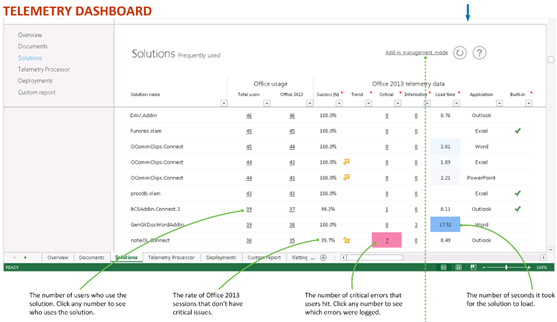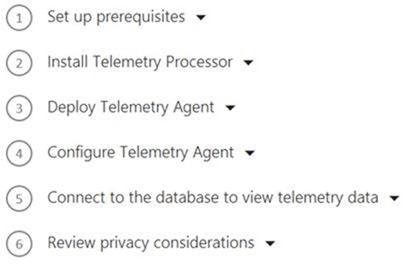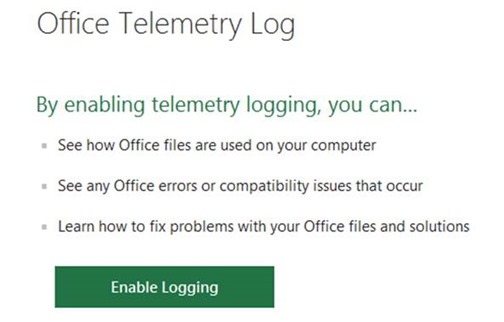Guest Post: Adding Telemetry to the already bulging Toolbox of the IT Pro
By Ed Baker
Office Compatibility
The modern IT pro has just been handed a great new productivity tool by Microsoft – Office Telemetry gives you the ability to ensure that all your carefully crafted in house add-ins, documents and solutions will work with the new Office as well as your current versions.
The Office team have worked very hard to examine all the common areas that frustrate us the IT Pro when trying to deploy a new version of the Office suite into our environments. The fruits of their labour is the new Office compatibility approach. A four step process. Collect, Analyse, Pilot, Deploy and Monitor.
The Office Telemetry Dashboard
The effects of the process are displayed in the Office Telemetry Dashboard, which is an excel solution for IT Professionals showing all the metrics of your Office documents, add-ins etc. You can see how often and by whom these documents are opened and any issues that are experienced by these users. You can discover their hardware, what has been deployed to them and how their documents are performing.
The Telemetry system is present and ready to implement when you install Office 2013.
There are a number of simple steps to enable the Telemetry Dashboard. Having opened the Telemetry Dashboard for Office 2013 Spreadsheet, the getting started worksheet outlines the steps to take. There is also a helpful Telemetry Dashboard guide in the same workbook. The dashboard is created from a complex process of data collection and analysis.
The lowest level element is the Telemetry Agent this is present in Office 2013 and is a free download and install to deploy to Office 2003, Office 2007 and Office 2010. The deployed agents collect all usage and compatibility data and sends the data to a central shared folder, this is then processed and imported into a SQL database. The Dashboard Spreadsheet then displays the data for the monitored clients in the format shown above. To get to this stage six steps are required, as shown below.
- Prerequisites – an installation of SQL server with create database permissions or access to a current one. (SQL Server versions from 2005 upwards are suitable including Express edition)
- Telemetry Processor – this requires installation on either an x86 or x64 windows computer and must have access to the SQL server and the shared folder containing the agent data to be processed. Available in the dashboard spreadsheet
- Telemetry Agent – already present in Office 2013 but must be deployed to Office versions from 2003 upwards. Again x86 or x64 versions are available from the dashboard spreadsheet.
- Agent Configuration – Group policy is used to enable the agent and configure the shared folder and data tagging options. Office 2013 admin templates are available for this.
- Connect to database - To allow other administrators to view telemetry data, you must add them to the td_readonly role on the database.
- Review Privacy – Collection of the data may well cause your organisation some concerns over the data stored. Three privacy options are available. Obfuscation of certain data such as location, name and title of document. Prevent specific applications or solutions from being reported to the dashboard. Only show solutions with more than a defined number of users. 9To apply a certain degree of anonymity).
Once installed, enabled and running, the telemetry dashboard has eight worksheets.
- Telemetry Dashboard guide
- Getting started
- Overview
- Documents
- Solutions
- Telemetry Processor
- Deployments
- Custom Report
All of these worksheets are described in detail in the TechNet worksheet reference
Office Telemetry Logging
Any business or network with a large number of Office users, whether on Office 2013 or any other version (2003 upwards) will benefit from the raw data collected and the potential time saving created by identifying the creaky or broken applications and solutions in circulation.
But, even if you are working in a very small environment, there are elements of this system that will be invaluable. The integral Telemetry Agent also allows for an individual to enable Telemetry Logging on their own PC. Once again the required files and services are installed with Office 2013 and once enabled provide a host of useful data. The telemetry log is a separate Office 2013 spreadsheet and from the guide worksheet the system is easy to enable.
Once enabled, the Events worksheet shows all office related events for that PC.
Logged information includes
- File names and add-in names
- Office events 9errors and compatibility information)
- System information (user name and computer name)
No file content is recorded and no data is sent to Microsoft.
It is unlikely that any standard user will learn of the usefulness of this tool, but as an IT Pro once enabled it will allow you to track down even the most awkward of Office based problems.
The Bottom Line
Office Telemetry is a huge subject and one that deserves its own dedicated hot-to guide (that’s for another time, maybe) for now, take a look at the Modern App – Server Posterpedia on Windows 8 in the Windows store, there you will find a number of Office 2013 tiles, one dedicated to Office Telemetry. If you want to dive even deeper, then the TechNet Office 2013 Telemetry Overview is a must and can be found here.
About the Author
 Ed Baker holds many Microsoft certifications including MCSE, MCT, and Office Master 2007 and 2010 as well as the new Excel 2013 and Word 2013 MOS certifications. Ed is a 20 year veteran of the IT industry currently contracting as an Enterprise Consultant and Trainer to Microsoft Certified Learning Partners including Firebrand Training, HP and Cloud Academy Live. Why not connect with Ed on LinkedIn, Twitter and Facebook.
Ed Baker holds many Microsoft certifications including MCSE, MCT, and Office Master 2007 and 2010 as well as the new Excel 2013 and Word 2013 MOS certifications. Ed is a 20 year veteran of the IT industry currently contracting as an Enterprise Consultant and Trainer to Microsoft Certified Learning Partners including Firebrand Training, HP and Cloud Academy Live. Why not connect with Ed on LinkedIn, Twitter and Facebook.





